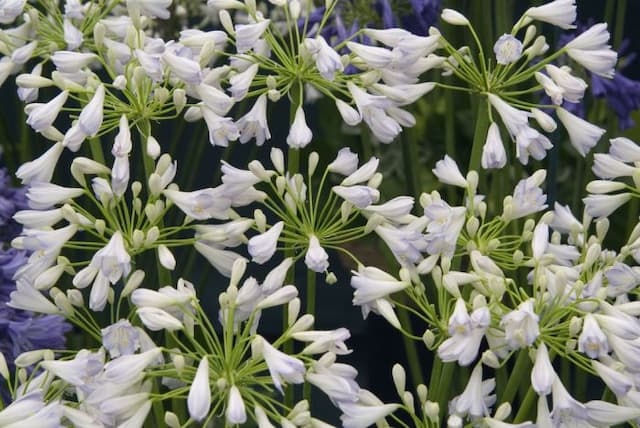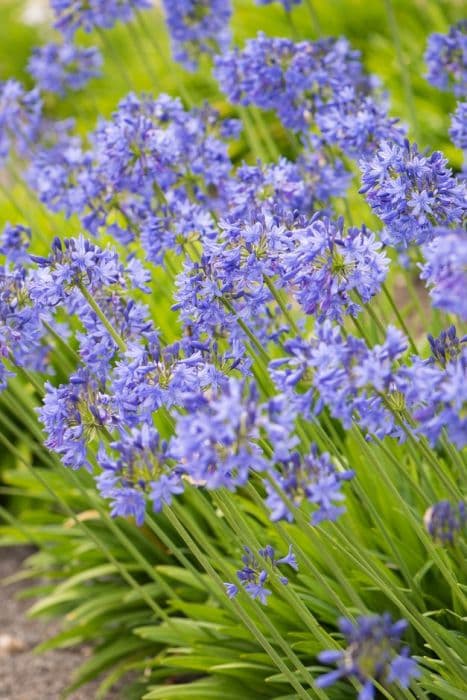African Lily Agapanthus 'Bressingham Blue'

ABOUT
Agapanthus 'Bressingham Blue', commonly known as Lily of the Nile or African Lily, is a striking perennial plant known for its lush foliage and stunning floral display. This variety features a deep blue-violet bloom, with numerous trumpet-shaped flowers tightly clustered at the end of sturdy, upright stems. The flowers form globe-shaped clusters that create a bold and eye-catching look during their blooming season. These blossoms are a popular choice for cut-flower arrangements due to their vibrant color and longevity. Beneath the floral spectacle, the plant showcases a base of strappy, arching green leaves that create a dense and grass-like clump. These evergreen leaves remain attractive throughout the seasons, providing a continuous display of greenery even when the plant is not in bloom. The contrast between the richly colored blooms and the verdant foliage presents a lush addition to any garden setting. The Lily of the Nile is a hardy variety that's often used in borders, containers, or as a focal point in floral gardens. This variety's ability to adapt to various growing conditions makes it a favored choice amongst gardeners looking for a reliable source of summer color.
About this plant
 Names
NamesFamily
Amaryllidaceae
Synonyms
African Lily, Lily of the Nile, Love Flower
Common names
Agapanthus 'Bressingham Blue'.
 Toxicity
ToxicityTo humans
The plant commonly known as Lily of the Nile is considered to have a level of toxicity to humans, although it is generally low. If ingested, parts of this plant can cause gastrointestinal symptoms such as nausea, vomiting, and diarrhea. In some cases, it has also been reported to cause skin irritation when handled, although this is not as common. It is advisable to handle the plant with care and ensure that it is not ingested, particularly by children, who might be more sensitive to its toxic properties.
To pets
Lily of the Nile is known to be toxic to pets, including dogs and cats. The ingestion of parts of this plant can lead to a variety of symptoms in animals, similar to humans. These symptoms may include nausea, vomiting, and diarrhea. In more severe cases, it has been reported to cause tremors or cardiac issues. It is important for pet owners to keep this plant out of reach of their animals and to seek veterinary care if there is any suspicion of ingestion.
 Characteristics
CharacteristicsLife cycle
Perennials
Foliage type
Deciduous
Color of leaves
Varies
Flower color
Blue
Height
2 feet (0.61 meters)
Spread
2 feet (0.61 meters)
Plant type
Bulb
Hardiness zones
8
Native area
South Africa
Benefits
 General Benefits
General Benefits- Ornamental Appeal: The Agapanthus, commonly known as the African Lily, features striking blue flowers that add color and visual interest to gardens.
- Drought Tolerance: Once established, the African Lily is fairly drought-resistant, making it suitable for xeriscaping or low-water gardens.
- Easy Maintenance: It requires minimal care beyond the basic watering and occasional feeding, making it ideal for gardeners of all levels of experience.
- Long Blooming Season: The African Lily typically has a long flowering period during the summer months, providing prolonged beauty in the landscape.
- Attracts Pollinators: The showy blooms attract bees, butterflies, and other pollinators, supporting local biodiversity.
- Container Gardening: It is well-suited for pots and containers, offering flexibility in garden design and the option to move plants as needed.
 Medical Properties
Medical PropertiesThis plant is not used for medical purposes.
 Air-purifying Qualities
Air-purifying QualitiesThis plant is not specifically known for air purifying qualities.
 Other Uses
Other Uses- Floral Arrangements: Agapanthus flowers, including those of the 'Bressingham Blue', are often used in floral arrangements due to their striking blue-violet blooms which can add a pop of color to any bouquet.
- Photography Prop: The 'Bressingham Blue' Agapanthus, with its attractive flowers, serves as an excellent photography subject for garden and nature photographers looking to capture its unique beauty.
- Erosion Control: Agapanthus plants can be planted on slopes or banks to help reduce soil erosion with their root system that helps stabilize the ground.
- Architectural Interest: In landscape design, 'Bressingham Blue' Agapanthus is used for its architectural foliage and flowers, offering height and structure to garden beds and borders.
- Theme Gardens: They can be integrated into blue-themed or monochromatic garden designs to maintain a specific color palette.
- Poolside Planting: The 'Bressingham Blue' Agapanthus is ideal for planting around pools where their reflective blooms complement the water's surface and they can tolerate the microclimate.
- Screening: Agapanthus 'Bressingham Blue' can be planted in rows to create informal screening, providing a sense of privacy without the need for a built structure.
- Container Gardening: These plants do well in pots or containers, allowing those with limited space to enjoy their stunning flowers on patios, balconies, or terraces.
Interesting Facts
 Feng Shui
Feng ShuiAgapanthus is not used in Feng Shui practice.
 Zodiac Sign Compitability
Zodiac Sign CompitabilityAgapanthus is not used in astrology practice.
 Plant Symbolism
Plant Symbolism- Love Letters: The Agapanthus, commonly known as African Lily, can symbolize love letters or a message to a loved one, as its name is derived from the Greek words 'agape' meaning love, and 'anthos' meaning flower.
- Beauty: African Lilies are often associated with beauty, owing to their striking blue or purple flowers which make them visually stunning and a popular choice in gardens for their aesthetic appeal.
- Enduring Love: The robust nature and long-lasting blooms of the African Lily can represent an enduring or long-lasting love or relationship.
- Unity: The clusters of flowers that form at the top of long stems in an umbrella-like pattern can symbolize unity or togetherness, as they all stem from a central point and grow together.
- Purity: The color of 'Bressingham Blue' may also be interpreted to represent purity and elegance, particularly in its striking cool blue tones that can evoke a sense of calm and serenity.
 Water
WaterLily of the Nile, commonly known as Agapanthus 'Bressingham Blue', requires regular watering to maintain evenly moist soil, especially during the growing season in spring and summer. It should be watered once a week with about 1 to 1.5 gallons of water per plant, but this can vary depending on climate conditions and soil type. During the hotter months, you might need to water more frequently to prevent the soil from drying out completely. It's important not to overwater, as this can lead to root rot. In winter, reduce watering to every other week or less, depending on the plant's dormancy and local weather conditions.
 Light
LightLily of the Nile thrives best in full sun conditions, receiving at least 6 to 8 hours of direct sunlight daily. The ideal spot for this plant would be in a south-facing garden or a spot that receives unfiltered sun throughout the day. If you are in a particularly hot climate, providing afternoon shade can help prevent leaf scorch.
 Temperature
TemperatureLily of the Nile prefers temperatures between 50°F to 80°F for optimal growth. It can survive minimum temperatures down to about 20°F but it can suffer damage if the cold persists. To encourage blooming, it's best to provide a period of cooler temperatures (50°F to 60°F) in the late fall and winter, followed by warmer temperatures (60°F to 75°F) in the spring.
 Pruning
PruningLily of the Nile should be pruned to remove spent flower stalks and to tidy up any dead or damaged leaves. This helps promote new growth and encourages more blooms in the following season. Pruning should be done after flowering, typically in late summer or early fall. It's not necessary to prune the plant very often; once a year for maintenance is usually sufficient.
 Cleaning
CleaningAs needed
 Soil
SoilThe African Lily 'Bressingham Blue' prefers a soil mix that is rich in organic matter, well-draining, and loamy. Amend garden soil with compost or a balanced potting mix when planting. This plant thrives in a pH range of 6.0 to 8.0.
 Repotting
RepottingAfrican Lilies should be repotted every 3 to 4 years to refresh the soil and provide room for root growth. Divide clumps if they become too crowded.
 Humidity & Misting
Humidity & MistingAfrican Lily 'Bressingham Blue' does well in average humidity conditions that are typical of outdoor environments; excessive humidity is not required.
 Suitable locations
Suitable locationsIndoor
Place in bright, indirect light.
Outdoor
Plant in full sun to partial shade.
Hardiness zone
7-11 USDA
 Life cycle
Life cycleThe life cycle of Agapanthus 'Bressingham Blue', also known as African lily, begins with seed germination, which occurs in warm, well-drained soil where the seeds develop into small plants. After germination, the seedlings grow into juvenile plants, developing their characteristic strap-like green leaves. As the plants mature, they form clumps with rhizomatous roots which store nutrients and energy for perennial growth. Each summer, mature African lilies produce tall, sturdy stalks topped with spherical clusters of blue flowers, and pollination during this stage can result in seed formation for propagation. Following the flowering phase, the plants enter a period of dormancy during colder months if grown in regions with seasonal climate changes, where they conserve energy in their roots for the next growing season. The life cycle continues year after year, with clumps increasing in size and potentially being divided for propagation or to control their growth in garden settings.
 Propogation
PropogationPropogation time
Spring-Early Summer
Agapanthus 'Bressingham Blue', commonly known as African Lily, is best propagated by division, which is its most popular method. The ideal time for division is in the spring right before new growth commences or in early fall after the blooming period has ended. To propagate by division, carefully lift the clump from the ground using a garden fork to minimize root damage. Gently tease apart the individual rhizomes, ensuring each division has at least one or two growing points or fans of leaves. Replant each division immediately into well-prepared soil with good drainage, placing them at the same depth they were previously and about 18 inches (approximately 45 centimeters) apart to allow sufficient space for growth. Water the new divisions well to help establish them. Over time, these divisions will mature into clumps that can be further divided, creating a continuous supply of new plants.








![African lily [Brilliant Blue]](/_next/image?url=https%3A%2F%2Fplants-admin.emdemapps.com%2Fimages%2Fplants%2F%2Fimages%2F604b5e3c28e2b.png&w=640&q=75)
